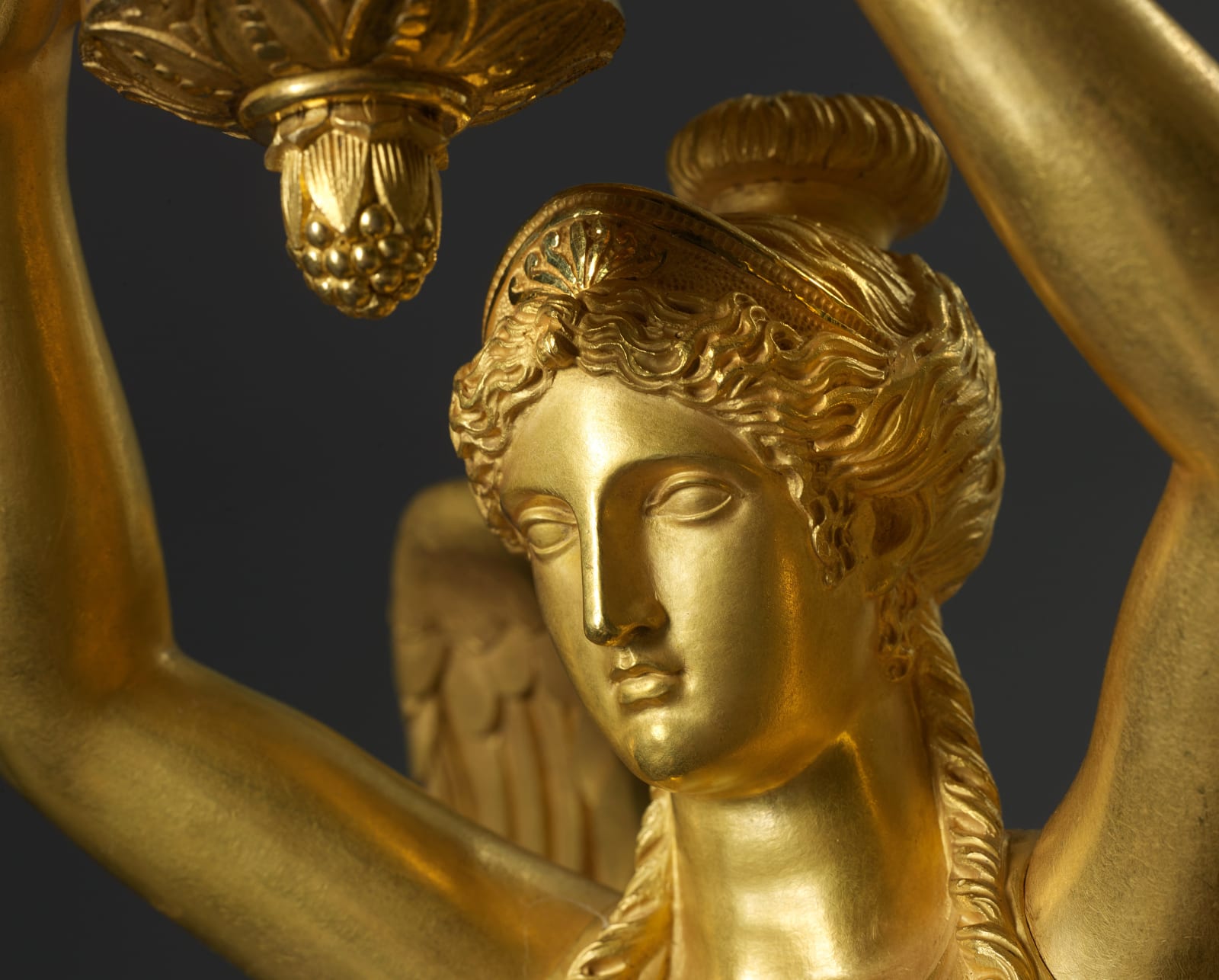Thomire et Cie (attributed to)
Further images
Literature
Connaisance des Arts, "Le XIXe Siècle Français, Peinture, Mobilier, Céramique, Orfèvrerie, Bronzes, Objets d'art, Tapis, Tissus, Papiers Peints, Sculptures, Ensembles Décoratifs", 1957, pl. 5, illustrating a comparable Thomire style candelabrum with similar hair style and dress but with much smaller butterfly wings, standing with both raised feet on a tessellated dome on a columnar plinth. Ottomeyer and Peter Pröschel, "Vergoldete Bronzen", 1986, p. 307, colour pl. XXXIX, illustrating a comparable pair of candelabra in the Villa Hardt, Eltville. And 328, pl. 5.2.1, illustrating two related studies from a detail on a sheet of designs by Charles Percier of circa 1802, now in the Metropolitan Museum, New York, for furnishings for Joséphine Bonaparte's boudoir at Château de Saint Cloud. And p. 328, pl. 5.2.2, illustrating one of a similar pair of candelabra of circa 1810 by Pierre-Philippe Thomire with Victory standing on one foot and noting that a related drawing of those candelabra appear in Thomire's album of 1817, now in the Stockholm National Museum. And p. 329, pl. 5.2.4, illustrating a similar pair of ten-light candelabra à la Victoire of circa 1810 by Pierre-Philippe Thomire in the Metropolitan Museum, New York. And p. 331, pl. 5.2.9, illustrating a similar candelabrum by Thomire of circa 1810, with both figures wearing similar dress, their hair likewise in a chignon though lacking the plaits and with both feet on a sphere. And p. 390, pl. 5.17.2, illustrating a lithograph of circa 1820 in the Cabinet d'Estampes in the Bibliothèque Nationale Paris, featuring two candelabra with putti standing on similar baluster-shaped plinths. And p. 392, pl. 5.17.9, illustrating a candelabrum by Thomire of 1832 in the Grand Trianon, Versailles with Victory wearing a very similar dress and closely related hairstyle and crown. Jean-Pierre Samoyault, "Pendules et Bronzes d'Ameublement Entrés sous le Premier Empire", 1989, p. 156, no. 133, illustrating a comparable pair of candelabra in the Château de Fontainebleau, which were acquired in 1804 for the salon de l'Impératrice. Giacomo et Rozenn Wannenes, "Les Bronzes Ornementaux et Les Objets Montes de Louis XIV à Napoléon III", 2004, p. 377, pl. 377, illustrating a similar pair of gilt bronze candelabra à la Victoire attributed to Thomire, with both figures standing on spheres but on rectangular malachite plinths mounted with the arms of the Russian Imperial family. And pp. 381 and 383, illustrating two other pairs of comparable candelabra in gilt and patinated bronze holding a similar vase issuing candle branches, with the figures again standing with both feet on a sphere but on columnar plinths. Marie-France Dupuy-Baylet, "Les Bronzes du Mobilier National 1800-1870 - l'Heure, le Feu, la Lumiére", 2010, no. 140, illustrating a comparable pair of twelve-light gilt bronze candelabra of circa 1821 and of similar large size delivered to the Palais de Tuileries and by 1824 recorded in appartement de la duchesse de Berry, featuring similar Victories with hair as here worn in a chignon and arranged below in plaits. And no. 141, illustrating another pair of comparable gilt bronze twelve-light candelabra à la Victoire by Feuchère of 1824 for the Ministère des Finances.
An exceptionally fine pair of late Empire mercury gilt bronze nine-light candelabra à la Victoire attributed to the celebrated firm of bronziers Thomire et Cie after a design by Charles Percier, each with a beautiful winged figure of Victory wearing diaphanous robes with a rounded neck line and gathered by a sash under her breasts above a long under skirt that splays out above her ankles, with a crown in her hair that is gathered up in a chignon and is then arranged in two plaits that fall onto her shoulders, her exquisite feathered wings flowing behind her as she looks downward while holding aloft a candelabrum formed as a vase mounted below by stiff leaves and a berried boss and crowned by an acanthus leaf top, issuing a central upright acanthus-wrapped candle branch mounted with fluted and anthemion bands surmounted by an acanthus leaf nozzle and a detachable flaming torch which when removed serves as the ninth candle holder, the central upright stem issuing from half way up four scrolled fluted trumpet-shaped and acanthus-wrapped candle branches with circular drip-pans and vase-shaped nozzles surrounded below by a ring of four further and similarly shaped candle branches, each figure of Victory standing on tip-toe with both feet on a plain sphere resting on an acanthus leaf support on a baluster-shaped plinth chased with curvaceous shaped tessellated panels enclosing a trio of beads above a band of anthemion on a stepped square base mounted on the upper side with anthemion and cast below with a foliate band
Height 123 cm, width 17.5 cm, depth 17.5 cm. each.
Paris, date circa 1820
The importance and beauty of these magnificent candelabra cannot be over emphasised. Given their superb quality, the finesse of the mercury gilding as well as their monumental size these candelabra would have been made for a large and important residence. Furthermore, they could only have been made by one of the finest bronziers of the day, most notably the pre-eminent fondeur-ciseleur Pierre-Philippe Thomire whose firm of Thomire et Cie created a number of very similar and closely related candelabra à la Victoire. Close inspection reveals the mastery of the chasing, from the free flowing robes that subtly outline the female form and the seemingly naturalistic feathered wings to Victory's hair worn up in a pronounced chignon above plaits that fall across her shoulder as well as the unusually decorated baluster-shaped plinths. The plinths are not only unusual in their decoration but also help date the candelabra to the latter part of the Empire period, comparing with other works by Thomire such as a smaller candelabrum with simple fluted shaft in the Grand Trianon, Versailles (illustrated in Ottomeyer and Pröschel, op. cit. p. 393, pl. 5.17.12).
The personification of Victory as a winged figure was well known in Antiquity as evidenced by a Roman model showing a very similar figure upon a sphere, now in the National Art Collection, Kassel (illustrated in Ottomeyer and Pröschel, op. cit. p. 329, pl. 5.2.3). The figure became an integral element within Empire design through the intervention of Charles Percier (1764-1838) and Pierre François Léonard Fontaine (1762-1853), Napoleon's most important architects and designers. The design for the present pair of candelabra is believed to have derived from a design by Charles Percier (as cited above) which was successfully exploited by Pierre-Philippe Thomire (1751-1843) as well as his contemporary Claude Galle (1759-1815).
Pierre-Philippe Thomire was the greatest craftsman of his age to work in gilt bronze who was not only patronised by Louis XVI, Napoleon Bonaparte and Louis XVIII but also numerous foreign monarchy and aristocracy. Born into a family of ciseleurs, he began working with the renowned bronzier Pierre Gouthière (1732-1813) as well as Jean-Louis Prieur (b. 1725 d. after 1785) ciseleur-doreur du roi, before opening up his own workshop in 1776. Famed for his production of finely chased gilt bronze objets de luxe, of which a large quantity were commissioned by the royal household, Thomire frequently collaborated with the marchands-merciers, such as Simon-Philippe Poirier and his successor Dominique Daguerre. In addition, Thomire supplied finely chased mounts to leading ébénistes of his day such as Guillaume Benneman (maître 1785, d. 1811) and Adam Weisweiler (1744-1820). Thomire also helped establish his name when working at the Sèvres Porcelain Manufactory, firstly as an assistant to its artistic director Jean-Claude Duplessis in making the factory's mounts and then following the latter's death in 1783, he took over Duplessis's job and in this capacity supplied all the gilt bronze mounts for the factory's porcelain. His post-Revolutionary success somewhat eclipsed his fame during Louis XVI's reign and in 1806 he became the first bronzier to be awarded a gold medal at the Exposition des Produits de l'Industrie. He won another gold medal in 1809, in which year he was also appointed ciseleur de l'Empereur.
In response to growing demand Thomire became an associate and then in 1804 purchased the extensive business owned by Martin-Eloi Lignereux, the famous marchand-mercier, formerly associated with Daguerre. Soon his newly named company Thomire-Duterme et Cie was employing a work force of about 800; it had a workshop at rue Boucherat and a showroom at rue Taitbout, from where Thomire retailed a large range of decorative objects inspired by antiquity including extravagant candelabra, surtouts and centrepieces, clock cases and monumental Greek and Roman style urns and vases. Like many Parisian trades, the firm encountered financial difficulties due Napoleon's continuing wars. Soon after 1815 the partnership with Duterme was dissolved and under its new style, Thomire et Cie, it thrived once more under the restored Bourbons. 1823 saw Thomire winning a gold medal for sculpture in Paris as well as his retirement from the firm though he continued to produce sculptures and regularly exhibited at the Paris Salon until 1834. His business was continued by his two sons-in-law and then his grandsons. Despite its closure in 1852, Thomire's legacy has continued for much longer as evidenced by the fact that his work can be found amongst some of the world's finest collections. Among the many, they include numerous former royal and imperial French châteaux, the Musée du Louvre in Paris, the Hermitage Museum in Saint Petersburg, the Metropolitan Museum, New York, the J. Paul Getty Museum, California as well as the British Royal Collection.







